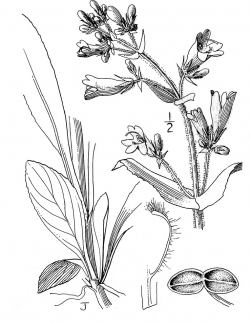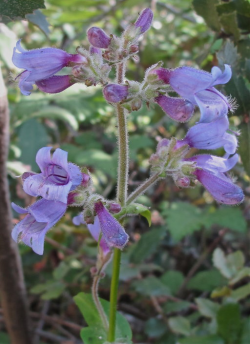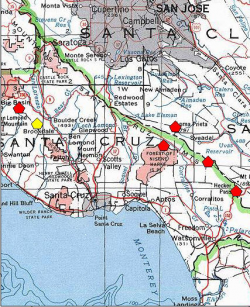
endangered

Illustration from Abrams (1951).

Photo taken in Bonny Doon © 2012 Dylan Neubauer.

A red polygon indicates an extant occurrence; yellow indicates the occurrence has been extirpated.



This fact sheet was prepared by Grey F. Hayes, Dean W. Taylor, and Dylan M. Neubauer under award NA04N0S4200074 from the National Oceanic and Atmospheric Administration (NOAA), U.S. Department of Commerce (DOC). The statements, findings, conclusions, and recommendations are those of the authors and do not necessarily reflect the views of the NOAA or the DOC.
© Copyright 2006, Elkhorn Slough Coastal Training Program
Last updated: Jul 23, 2021 17:30
Common Names - Santa Cruz Mountains beardtongue
Family - Plantaginaceae (Plantain Family)
State Status - none
Federal Status - none
Habitat
Openings in conifer forest or oak woodland, in recently burned or disturbed chaparral, or along roadcuts; 400–1000 m.
Key Characteristics
Perennial herb 25–120 cm tall from caudex, herbage ± glabrous; main cauline leaves thin, 25–140 mm long, narrowly elliptic, slightly narrowed just distal to rounded to truncate base (where widest), shallowly toothed, ± = basal lvs; inflorescence glandular; corolla blue-violet, 20–30 mm long, the upper portion abruptly expanded to throat, generally on upper side, ± white within, glandular externally, floor ± hairy; anther sacs 1.3–1.7 mm long, dehiscing their entire length, the valves barely spreading; staminodes bearded (Wetherwax and Holmgren 2013). In the Santa Cruz Mountains, P. heterophyllus is the only congener and is also uncommon locally (on the east side of the Santa Cruz Mountains)—it has linear, smaller leaves, a glabrous staminode, and anthers that dehisce only at the apex, the valves remaining parallel; in general it is a more suffrutescent but smaller plant.
Flowering Period
May to June
Reference Population
The Forest of Nisene Marks State Park (Santa Cruz County).
Global Distribution
Endemic to the Santa Cruz Mountains in Santa Clara and Santa Cruz counties.
Conservation
In 2011, ca. 100 plants were reported from Bonny Doon after an area in chaparral was cleared for fire management (Neubauer 2013). As of 2021, several small populations persist in Bonny Doon along Empire Grade. Approximately 300 plants were reported in 2021 from the Forest of Nisene Marks State Park in knobcone pine/brittle-leaf manzanita chaparral in an area that had experienced a prescribed burn two years previously. Surveys in the CZU-Lightning Complex Fire perimeter (August 2020) have not yet revealed the presence of new populations.
References
Abrams, L. R. 1951. Illustrated Flora of the Pacific States, Vol. 3. Stanford University Press, Palo Alto, CA.
California Natural Diversity Database (CNDDB). 2015. California Department of Fish and Wildlife RareFind 5. http://www.dfg.ca.gov/biogeodata/cnddb/mapsanddata.asp [accessed 15 February 2015].
CNPS, Rare Plant Program. 2011. Penstemon rattanii var. kleei, in Inventory of Rare and Endangered Plants (online edition, v8-02). California Native Plant Society, Sacramento, CA. http://www.rareplants.cnps.org/detail/1236.html [accessed 21 February 2015].
Neubauer, D. 2013. Annotated Checklist of the Vascular Plants of Santa Cruz County, California, Second Edition. California Native Plant Society, Santa Cruz County Chapter, Santa Cruz, CA.
Wetherwax, M. and N. H. Holmgren. 2013. Penstemon rattanii var. kleei, in Jepson Flora Project (eds.). Jepson eFlora, http://ucjeps.berkeley.edu/cgi-bin/get_IJM.pl?tid=76778 [accessed 21 February 2015].
